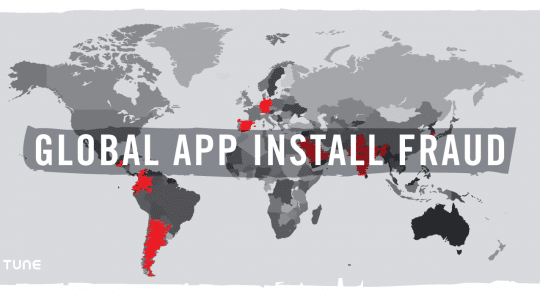‘Competitive Intelligence’ is a term that is commonly thrown around when discussing app store optimization (ASO). However, you don’t hear many explanations on how you can use competitors to actually make your app better or increase your app’s visibility. Competitive intelligence drives downloads for your app by improving your mobile marketing strategies and your product offering. This post will discuss both marketing and product development, and how competitive intelligence fits into those facets.
The Slideshare presentation below is a deck our CEO, Ian Sefferman, put together for how to use competitive intelligence to drive downloads. There is also content accompanying the Slideshare which goes into more detail about using competitive intelligence.
Using Competitive Intelligence To Improve ASO and Organic App Marketing
How can you use competitive intelligence to improve your organic marketing? Before we dive into this, we should clarify that when we talk about organic channels, we mainly mean ASO, which is the process of driving downloads for an app by rising in the app stores’ search results. Here are some tips to improve ASO and organic app marketing using competitive intelligence to find keywords.
Find the keywords your competitors are using
 Finding the keywords your competitors are actually using can highlight new terms which you might want to consider using. You can find which keywords your competitors are using by manually or automatically (through the use of our product’s Competitor Keywords feature) highlighting the top keywords they rank for. For example, here are a few of the keywords the Nike+ Running app ranks the highest for, and which they are therefore most likely using.
Finding the keywords your competitors are actually using can highlight new terms which you might want to consider using. You can find which keywords your competitors are using by manually or automatically (through the use of our product’s Competitor Keywords feature) highlighting the top keywords they rank for. For example, here are a few of the keywords the Nike+ Running app ranks the highest for, and which they are therefore most likely using.
Deduce your competitors keyword strategy
 Finding your competitors’ keywords will also give you a sense of what strategy they are using by identifying patterns within their keywords. For example, by looking at the keywords Target ranks highly for, we can see that they are making a push for free incentives to their customers, because ‘free’ is used a number of times. Once you have a sense for what strategy your competitor might be pursuing, you can then decide to challenge them on that strategy or blaze a different path.
Finding your competitors’ keywords will also give you a sense of what strategy they are using by identifying patterns within their keywords. For example, by looking at the keywords Target ranks highly for, we can see that they are making a push for free incentives to their customers, because ‘free’ is used a number of times. Once you have a sense for what strategy your competitor might be pursuing, you can then decide to challenge them on that strategy or blaze a different path.
Scan competitor reviews for keyword ideas
Another channel for aggregating keywords is to scan your competitors’ reviews. Compile a list of all your competitor reviews and sort them into groups based on star ratings. These reviews will be great for finding the language used about their app while also providing more ideas for keywords.
The 4- and 5-star reviews will be a good place to look for positive keywords associated with their app (i.e. words you want to either leave to them or compete for), and the lower stars will be a good place to find negative keywords (i.e. words you can attempt to target or leave alone).
Now you should have a fairly comprehensive list of keywords which are derived from competitive intelligence. You can then do more in-depth keyword research on each of these keywords and identify areas where you are doing well. You can also see areas your competitors are doing well, and assess whether or not you want to attempt to compete for those keywords or leave them be. This will greatly improve your ASO strategy, by highlighting smaller, more attainable areas to focus your keyword resources.
Using Competitive Intelligence To Improve Paid App Marketing
Those are some of the measures you can take to use competitive intelligence to drive downloads through organic marketing. But what about paid marketing? Here are a few tips for using competitive intelligence to help your paid marketing:
Find when competitors have implemented paid campaigns
One way to do this is to look at the Top Charts rankings for their app over time. As we can see here, Candy Crush started out with some high rankings driven by their fanfare and pre-release marketing, but then quickly dropped down below 100. Just as quickly, however, they bounced back with a sudden spike back up into the top 5. 
This spike was most likely caused by a large paid campaign that King (the publisher) does through TV, video, text, and banner ads. They used the time when their rankings dropped to figure out metrics such as the lifetime-value (LTV) of their customers, so they knew exactly how much they could afford to spend on paid marketing.
Find which keywords are optimized in their paid campaigns
The paid marketing most likely resulted in an increase of downloads and download velocity, which not only moved them up the Top Charts, but also improved their rankings for whatever keywords they were using at the time. If their rankings for certain keywords increased over the same period that their Top Charts rankings spiked, they were most likely using those keywords during their paid campaign. If the paid campaign took place recently, or they have managed to keep a steady ranking following their campaign, you might want to avoid those keywords because they will be harder to rank for.
Create a timeline for your competitors’ paid campaigns
Another question to ask yourself is: how long can my competitors sustain a paid marketing strategy? One way to get a good gauge on this is to observe how they are doing in the Top Charts versus how they rank in the Top Grossing apps. If your competitors have recently climbed quickly up the Top Charts (indicating they are implementing a paid campaign), but are not rising in the Top Grossing ranks, their paid marketing strategies will probably not last long because it is not driving significant revenue.
Pulling all this information together can help you with your app’s paid install strategy. You can use all the data to see if paid marketing has worked for your competitors by viewing how their Top Grossing or Top Charts ranks have been influenced and decide if you want to implement a paid strategy for your app. You can also decide if you want to use the same or different keywords your competitors used.
Using Competitive Intelligence To Improve Product Strategy
We’ve gone over how competitive intelligence can help drive downloads through marketing, but another way it can help is through product development.
Aggregate reviews
We will go back to the reviews again for this. If you didn’t aggregate your competitor reviews (or use a tool to do it for you) to help with organic marketing improvements, you will want to do that for your product strategy. Again, pull out common messaging to find how users are talking about your competitor’s app.
Find ideas for product features
You can learn a lot by combing through these reviews. You can find features your competitors have that people love and add them your product feature set or you can use those features as points of differentiation. If it is clear that your competitor is dominating a certain feature, use that information and focus on developing different features within your app. Scanning through the lower 1- and 2-star reviews can also highlight aspects you don’t want to add (because users don’t use or like them) or once again bring to light areas of differentiation. Is there a feature your competitor has that users are complaining about, which you could make better? In the example below, we see users love that they can both easily buy and sell items in the eBay app. If you were to create a competing app, these reviews would highlight the necessity to provide both of those features. 
You should constantly be trying to improve your organic marketing, paid marketing, and product offering. However, that is much easier said than done. Hopefully this post helped you understand how to use competitive intelligence to help develop those three facets, and ultimately drive more downloads. Let us know if you have any questions, we are always reachable on Twitter @MobileDevHQ or email at [email protected].
Author
Becky is the Senior Content Marketing Manager at TUNE. Before TUNE, she handled content strategy and marketing communications at several tech startups in the Bay Area. Becky received her bachelor's degree in English from Wake Forest University. After a decade in San Francisco and Seattle, she has returned home to Charleston, SC, where you can find her strolling through Hampton Park with her pup and enjoying the simple things between adventures with friends and family.




Leave a Reply
You must be logged in to post a comment.